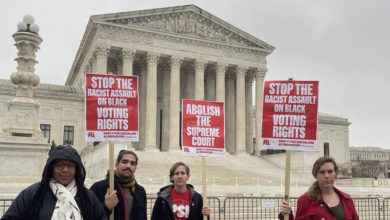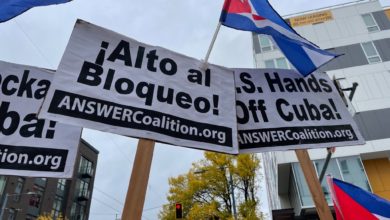The Cuban people voted by supermajority on Sept. 25 to approve the Families Code, a revolutionary law that modernizes, recognizes and legalizes all manifestations of families in Cuba.
The previous 1975 Family Code was revolutionary for its time, but needed a major updating with almost 50 years of growth in social consciousness worldwide and in Cuba. The new Families Code broadens the family model to be fully inclusive. It includes the right to same sex marriage, expanded rights of adoption, allows surrogacy births, more protection for seniors and grandparents’ rights, stronger protections against domestic violence and explicit expansion of the rights of children.
Composed of 471 articles and 117 pages, the hefty code details the fullest inclusion of every Cuban’s family as one sees fit, and “defends equality, non-discrimination, dignity and respect for diversity.”
Of 6,251,786 eligible voters, 74.01% turned out to vote. Of these, a supermajority of 66.89% approved
the Families Code.
Whole population discussed and debated the code’s provisions
The whole population was involved in a massive discussion, deliberation and debate on the draft code. Tens of thousands of workplace, neighborhood and mass organization meetings took place involving more than six million Cubans. Some 900,000 interdisciplinary personnel organized the consultation process, including lawyers, jurors, students and the Committees in Defense of the Revolution.
The draft code was available via the internet, including to Cuban nationals in other countries, to
allow them to submit questions and recommendations. In-person discussions were held at embassies during the month of March for Cubans living abroad.
Thousands of suggestions, critiques and revisions were considered with many accepted. The Families Code draft was finalized on Aug. 17 and published in the Official Gazette for a vote on Sept. 25.
Code reflects developing mass consciousness
The Families Code is unique in the world and it reflects the consciousness of the Cuban people
moving toward deeper cooperation, solidarity, understanding and love. It proves the ever-forward direction of Cuba’s Revolution in defending and expanding true people’s democracy even in the midst of a devastating U.S. economic blockade and U.S. attempts at subversion.
This is in stark contrast to the United States where women’s right to abortion was just dealt a huge blow, where the Supreme Court is eviscerating voting rights of Black and other people of color, and where state repression is growing. The very concept of a national referendum does not exist in the United States.
People’s democracy through referendum
In Cuba’s revolution, every new major social, political or economic policy is presented to the population as a proposal for nationwide debate and input. After revisions, each proposal is put to a democratic vote by all eligible voters 16 years old and older.
For example, the new 2019 Cuban Constitution was drawn up in a five-year process which included the participation of the National Assembly, the Communist Party, jurists, legal experts and the country’s mass organizations. After a full popular process of debate, it received 86.9% approval by voters with over 85% voters turning out.
Right after the Constitution was approved, the government, party and civil society began to prepare a campaign to update the 1976 Family Code even including the new name “Families Code” to signal the coming code’s inclusive nature.
It underwent a similar extensive popular consultation as the Constitution. Public meetings began on Feb. 1, after the National Assembly approved the draft proposal written by a commission composed of the Communist Party of Cuba, the National Assembly for Peoples Power, the Ministry of Justice, sociologists, psychologists, family experts and more. This period concluded at the end of April with suggestions, comments and edits brought by the people.
From April on, promotion of the draft was in full swing to engage everyone in continued discussion and to explain how the Families Code will benefit each and every Cuban. It appeared in television announcements, on national talk shows, in newspapers, community meetings, in every venue possible. President Miguel Díaz-Canel met with multiple communities, including leaders of the LGBTQ community, in an open exchanges of ideas. The message was clear — it is a code to benefit all Cubans.
Cuba’s colonial-era code
In 1889, the Spanish colonial code enforced highly patriarchal social norms on the island of Cuba. As in all class society, men were legally favored while women were subjugated, religious marriage was exalted and ‘illegitimate’ children were rendered socially unequal. In the 1940s, progressive forces pushed for laws to update the colonial family code. Their efforts resulted in the passing of Act 9/50 on the Civil Equalization of Women, which provided for the equality of spouses and children. But the realization of that code was not possible due to the weight of patriarchal norms and Cuba’s status as a U.S. neocolony.
With the triumph of the socialist revolution on Jan. 1, 1959, the first actions of the revolution included fighting for economic and social justice and targeting racism and sexism. The ban on racism, the agrarian reform, the end of evictions and the nationalizations were all part of the sweeping revolutionary changes in the first two years.
Overcoming women’s oppression became an immediate task. The Federation of Cuban Women (FMC) — led by legendary Vilma Espín — rose up as the organization to mobilize and educate women, incorporating them more fully into society as true equals to men.
In 1975, the first revolutionary Family Code was enacted to push for that goal of a more equal society within socialism. This code required “men to participate equally in domestic labor, guarantees equal rights to women and men in marriage and divorce, equal parental rights, and equal property and social rights for women in the home.” It was truly revolutionary for its time anywhere in the world.
LGBTQ equality guaranteed
The passing of decades since this code’s enactment saw deepening social movements worldwide for LGBTQ and women’s liberation, as well as for the equal rights for disabled people, seniors and the rights of children. This spurred Cuba to put into law many new social practices and norms and to expand new ones, especially full rights for LGBTQ people.
For several years now the Cuban government and the Cuban National Sex Education Center (CENESEX)
have sponsored National Days Against Homophobia and Transphobia, which have been promoted in
schools and through community activities. Almost 45 years after the first Family Code, the right of same-sex marriage and adoption and other guarantees for the LGBTQ community was essential for a new Families Code. These rights are now included in detail.
The new Family Code makes significant changes to the adoption process. Previously, only straight married couples could adopt children. The new code empowers all couples — straight or gay, married or single — to adopt children, as well as having children by surrogacy.
It is this subject that became perhaps the biggest point of contention, due to prejudices within some of the population and patriarchal ideas still to be grappled with. Some individuals who voted “no” to the code said they felt strongly that a child “needs a mother and a father.” The Catholic church hierarchy and some evangelical churches beat the drums of reaction and urged a “no” vote. The U.S. government weighed in with funding to rightwing Cubans in Miami, and counterrevolutionaries and religious entities on the island that sought to demonize the societal progress detailed in the Families Code.
Those reactionaries were not given an airing by Cuba’s media or by any of Cuba’s leading bodies as their views run contrary to Cuba’s socialist ideals, its Constitution and the Families Code.
Striving for consensus
Even before the campaign for the Families Code was launched, the Cuban leadership understood that declaring such rights by the government would not be enough. The Cuban Revolution has always strived for consensus through political persuasion, education and unity. Therefore, to promote unity for inclusivity and in respect for all, throughout Cuba for the last three years social messaging, popular mobilizations, cultural presentations, statements by many cultural, political, youth and social leaders have given strong support for a “yes” vote to the code.
Long known in the effort is Mariela Castro, director of CENESEX and committed Cuban revolutionary. She said the code, “settles a historical debt to equality, to the right of all people to marriage, affective de facto unions, adoption and the use of assisted human reproduction techniques.”
Strengthening children’s rights
The Families Code strengthens children rights to be involved in decision that affect them in the home and guarantees them progressive autonomy, that their opinions to be heard by adults, and to a childhood free of violence, negligence, abuse and discrimination, both in real life and online. The old code described “parental authority” in relation to one’s children. The new one describes that relationship as “parental responsibility,” with respect for children’s ability to advocate for themselves together with their parents.
The new code outlaws child marriage. The previous legal age for marriage of 14 has now been revised to 18 years of age. This provides the opportunity for adolescents to enjoy their youth and focus on education.
Seniors
Article 4 of the proposed bill enshrines the right of older adults to self-determination, independence and equal opportunities in family life, and legally integrates them into society. According to Article 8, “The State recognizes the importance of grandmothers and grandfathers in the intergenerational transmission of traditions, culture, education, values, affections and in care work.”
Parental responsibility
Love, affection and solidarity are the basic tenets for each family and the guiding principle in the governance of the law. Article 50 describes the different forms of parentage: natural procreation, parentage by adoption, parentage by assisted reproduction — artificial insemination and/or use of other genetic material from a third party — and the responsible person’s parentage regardless of genetic makeup of the child. Surrogate pregnancy, called “solidarity gestation” in the code, provides for protection and respect of all involved. It provides legal norms for those who act as parent or for the child, including stepparents.
The new Families Code stands true to the vision of Fidel, Raúl and Vilma. Gerardo Hernández, National Coordinator of the Committees in Defense of the Revolution, summed it up best. Just before the vote he said, “In the real Cuba, Cubans are moving steadily into the future, and we are close to achieving a Code of Families that will be among the most advanced, that exalts human dignity as a supreme value and that will bring us closer to [national hero Jose] Martí’s dream of a Cuba ‘with all and for the good of all.’”
Photo credit: Granma, Ariel Cecilio Lemus




